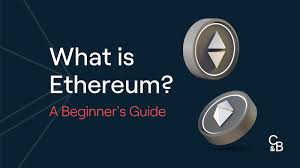Introduction
Ethereum is one of the most talked-about technologies in the world of blockchain and cryptocurrency. But what exactly is Ethereum, and how does it work? If you’re new to the concept, this guide will break it down in simple terms.
Unlike Bitcoin, which is primarily a digital currency, Ethereum is a decentralized platform that enables developers to build and deploy smart contracts and decentralized applications (DApps). It has its own cryptocurrency called Ether (ETH), but its functionality goes far beyond just being a digital coin.
In this article, we’ll explore:
- What Ethereum is and how it works
- The difference between Ethereum and Bitcoin
- Smart contracts and decentralized applications (DApps)
- The Ethereum blockchain and its key features
- Ethereum 2.0 and its upgrades
- The future of Ethereum
By the end, you’ll have a clear understanding of Ethereum and why it’s considered a revolutionary technology.
What is Ethereum?
Ethereum is an open-source, blockchain-based platform that allows developers to create and run decentralized applications (DApps) and smart contracts. It was proposed in 2013 by a programmer named Vitalik Buterin and officially launched in 2015.
Unlike traditional apps that run on centralized servers (like those owned by Google or Facebook), DApps run on a decentralized network of computers (nodes) spread across the world. This makes them more secure, transparent, and resistant to censorship.
Key Features of Ethereum
- Decentralization – No single entity controls Ethereum.
- Smart Contracts – Self-executing contracts with predefined rules.
- Ether (ETH) – The native cryptocurrency used for transactions.
- EVM (Ethereum Virtual Machine) – A runtime environment for smart contracts.
- DApps (Decentralized Applications) – Applications built on Ethereum.
How Does Ethereum Work?
Ethereum operates on a blockchain, similar to Bitcoin. However, while Bitcoin’s blockchain is designed to track ownership of digital currency, Ethereum’s blockchain is designed to run programmable smart contracts.
1. Blockchain Technology
A blockchain is a distributed ledger that records all transactions across a network of computers. Each block contains a list of transactions, and once added, it cannot be altered.
2. Smart Contracts
Smart contracts are self-executing agreements written in code. They automatically execute when certain conditions are met, eliminating the need for intermediaries like banks or lawyers.
Example:
- A vending machine is a simple real-world example of a smart contract. You insert money, select a product, and the machine automatically delivers it without human intervention.
3. Ether (ETH) – The Fuel of Ethereum
Ether (ETH) is Ethereum’s native cryptocurrency. It is used to:
- Pay for transaction fees (known as “gas fees”).
- Reward miners (or validators in Ethereum 2.0) for securing the network.
- Facilitate decentralized finance (DeFi) transactions.
4. Ethereum Virtual Machine (EVM)
The EVM is the engine that executes smart contracts. It ensures that all nodes on the network run the same code and produce the same results, maintaining consistency.
Ethereum vs. Bitcoin: What’s the Difference?
| Feature | Bitcoin | Ethereum |
| Purpose | Digital currency | Smart contracts & DApps |
| Founder | Satoshi Nakamoto | Vitalik Buterin |
| Block Time | ~10 minutes | ~15 seconds |
| Consensus | Proof of Work (PoW) | Moving to Proof of Stake (PoS) |
| Supply | Capped at 21 million | No hard cap (but issuance is controlled) |
While Bitcoin is mainly used as a store of value (like digital gold), Ethereum is a programmable blockchain that supports a wide range of applications, including DeFi, NFTs, and more.
Smart Contracts and Decentralized Applications (DApps)
What Are Smart Contracts?
Smart contracts are digital agreements that run automatically when conditions are met. They are written in programming languages like Solidity and deployed on the Ethereum blockchain.
Use Cases:
- DeFi (Decentralized Finance) – Lending, borrowing, and trading without banks.
- NFTs (Non-Fungible Tokens) – Unique digital assets like art and collectibles.
- Supply Chain Management – Tracking goods transparently.
- Voting Systems – Secure and tamper-proof elections.
What Are DApps?
DApps are applications that run on a decentralized network instead of a single server. Some popular Ethereum DApps include:
- Uniswap – A decentralized exchange (DEX).
- Aave – A lending and borrowing platform.
- OpenSea – An NFT marketplace.
Ethereum 2.0: The Future of Ethereum
Ethereum has faced challenges like high gas fees and scalability issues. To solve these, Ethereum is transitioning to Ethereum 2.0 (Eth2), a major upgrade that includes:
1. Proof of Stake (PoS) Consensus
- Replaces energy-intensive Proof of Work (PoW) with Proof of Stake (PoS).
- Validators (instead of miners) secure the network by staking ETH.
- More energy-efficient and scalable.
2. Sharding
- Splits the blockchain into smaller pieces (shards) to improve speed.
- Increases transaction capacity from ~30 TPS (transactions per second) to potentially 100,000 TPS.
3. Lower Gas Fees
- With improved scalability, transaction costs are expected to decrease.
The Future of Ethereum
Ethereum is at the forefront of blockchain innovation. Here’s what the future may hold:
- Mass Adoption of DeFi & NFTs – More financial and digital asset applications.
- Enterprise Use Cases – Businesses using Ethereum for supply chain, identity verification, etc.
- Web3 & the Metaverse – Decentralized internet and virtual worlds powered by Ethereum.
Conclusion
Ethereum is more than just a cryptocurrency—it’s a global, decentralized computing platform that enables smart contracts and DApps. With Ethereum 2.0, it aims to become faster, cheaper, and more sustainable.
Whether you’re interested in DeFi, NFTs, or blockchain development, Ethereum offers endless possibilities. As the ecosystem grows, Ethereum could play a key role in shaping the future of the internet and finance.
Key Takeaways
✅ Ethereum is a blockchain platform for smart contracts and DApps.
✅ Ether (ETH) is its native cryptocurrency used for transactions.
✅ Smart contracts automate agreements without intermediaries.
✅ Ethereum 2.0 upgrades will improve scalability and reduce fees.
✅ The future of Ethereum includes DeFi, NFTs, and Web3.
If you’re curious about blockchain technology, Ethereum is a great place to start exploring!
Did you find this guide helpful? Share it with others who want to learn about Ethereum! 🚀

